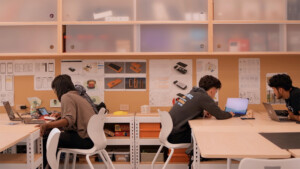The Case for School Makerspaces, According to Those Who Use Them

Inside a makerspace at Indian Trace Elementary School in Broward County, Florida, some kids are sitting, working by themselves. A group of others stand together staring intently at something, talking, and moving their arms energetically. Students are doing without adult direction. There’s an overall sense of purpose that is visceral. The energy feels more like that of a trendy dot-com startup than an elementary school media center.
This environment is part of a larger maker movement that acknowledges 21st Century natives need to learn in settings that are very different than the musty libraries or classroom rows of their parents. Makerspaces are areas where students come to explore, build, create, and tinker. Students are learning without turning to the front of the room for directions or receiving steps from the teacher at the center. They are the ones directing the action. They use a variety of materials from paper and cardboard to Legos to high-tech robots. It’s a mixed bag of art supplies, erector sets, paper mache, 3-D printers, green screens, drones, and more. Each space has its own unique set-up and feel based on the needs, interests, resources and goals of the community.

Though makerspaces began outside of schools, a growing number of educators have seen the value in creating these kinds of spaces in school media centers and classrooms in recent years. Transforming parts of a school into a makerspace is often a difficult step given ever-shrinking school budgets and an increasing focus on state standards and test scores.
I recently talked with some innovative educators who have created these spaces in their elementary schools. I also observed and heard from some of their students to better understand what they gain from these makerspaces. Collectively, they noted the academic benefits, development of 21st-Century Skills, and the ability to get students to approach learning with a growth mindset.

Academics: “A place to ignite and activate creative, design thinking”
When asking students to describe their school makerspace, the overwhelming response was “fun!” Educators utilizing these spaces realize that there is a tremendous amount of learning and skill-building embedded in that fun. Employers who need workers with critical thinking skills have begged educators to promote them in schools. These critical thinking skills are the basis for success in makerspaces. When working on a project, students establish a goal, create a plan for how to get there, and problem solve using trial and error in real-world scenarios. Lynne Oakvik, Curriculum Supervisor, Library Media for Broward County Public Schools, describes media center makerspaces as “a place to ignite and activate creative, design thinking.” Identifying a problem or goal, analyzing and evaluating the issues involved, and devising creative possible solutions is the work of makerspaces.

Though sometimes confused as solely open play and contemporary arts and crafts, educators have found that makerspace projects provide more engaging opportunities to reach standards-based expectations than yet more textbook or worksheet time. Donna Kouri, who is the Library Media Center Director and led the creation of a makerspace at Longwood Elementary School in Naperville, IL described a project where 5th-grade students worked together to create a video game. In creating the game, the students had to create characters, design the setting, and write the plot. They programmed the video game and wrote a how-to guide for teachers to play the game. This single project built English Language Arts, writing, and coding skills, in a way that was exciting and engaging for the students. Dr. Lisa Milenkovic, who has led the creation of STEM-based makerspaces in Broward County Public Schools, noted that “Students get to a higher depth of knowledge because they are applying what they are learning to a real problem.”
Twenty-First Century Skills: “When they’re creating, they just start talking!”
Educators know that in order for today’s students to be college and career ready, they need to develop 21st Century Skills including collaboration, creativity, and communication. Finding authentic ways to accomplish this in a classroom setting can be challenging. Makerspaces lend themselves to developing these skills in organic and productive ways. Projects often benefit from the input and thinking of multiple students. Dione Mila, Library Media Specialist for Indian Trace Elementary explained that “Collaboration and teamwork happen naturally. You don’t have to push it. You just give them a challenge and it will happen.” Teamwork is essential to the success of projects. Engaging and productive work is the best antidote to differences and fear.

Educators note that this environment also allows students who are not always successful in traditional classrooms to shine. Thinking outside of the box can be integral to success in a makerspace. Kouri noted that in her makerspace, “I’ll see students who don’t necessarily get along talking and helping each other. When they’re creating, they just start talking.” Second only to commenting on the “fun” of makerspace projects, students mentioned the opportunity to help each other on projects as their favorite thing about their makerspace time.
Growth Mindset: “Failure is part of the process.”

Learning is a process. A traditional approach to education has been to tell students what they should know. Makerspace environments value process along with product. Oakvik notes that these spaces give students an opportunity for “inquiry and discovery.” And sometimes that discovery happens in the “un-making” of things. Cynthia Felton, who worked to create a makerspace at Gator Run Elementary School also in Broward County, Florida, explained that students love the “Deconstruction Zone” where they are able to “disassemble old electronics, toys, and other household items. As they remove the screws and layers, their curiosity builds. They ask questions, and investigate how they work.” These makerspace students explore, experiment and discover. In short, they learn how to learn.
They also learn how to fail. People often think of school as being graded on whether you are right or wrong. Getting it completely right the first time is viewed as the pinnacle of success. But this is not the way the real world works. A much more useful skill than simply getting something right is learning how to react productively when something goes wrong. Makerspaces provide students with real problem-solving opportunities that require this resilience. As Kouri put it, “failure is part of the process.” A natural part of solving a problem is trying something that does not work. Kids working on projects in makerspaces can fail in a safe environment. Kouri explained that, in her school’s makerspace, students must “stick with the thing they start.” With that, they can learn the satisfaction and success of persisting to find another option.
Beyond Makerspaces

A fourth-grade student describing his makerspace experience said, “It doesn’t feel like school work. It feels like I’m playing.” The “playing” this student was talking about involved collaborating with a group of peers to program and test a robot.
These makerspace projects far surpass the shoebox dioramas of the last generation. However, it is the experience, rather than the product, that truly moves learning forward. The process of creating, setting goals, working with peers, and problem-solving until success is achieved engages students in a way that few traditional classroom experiences allow. The educators creating and promoting these spaces are ensuring that their learners are truly prepared to explore, ask questions, collaborate with others, and ultimately solve the challenges they will meet when they leave these schools.
For more, see:
- Take a Tour of Our School’s Makerspace
- Prepping a Learning Space to Grow Into a Makerspace
- Top 10 Things You Didn’t Know Your Makerspace Needs
Stay in-the-know with all things EdTech and innovations in learning by signing up to receive the weekly Smart Update.








0 Comments
Leave a Comment
Your email address will not be published. All fields are required.